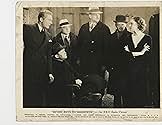अपनी भाषा में प्लॉट जोड़ेंA writer, looking for some peace and quiet in order to finish a novel, takes a room at the Baldpate Inn. However, peace and quiet are the last things he gets, as there are some very strange ... सभी पढ़ेंA writer, looking for some peace and quiet in order to finish a novel, takes a room at the Baldpate Inn. However, peace and quiet are the last things he gets, as there are some very strange goings-on at the establishment.A writer, looking for some peace and quiet in order to finish a novel, takes a room at the Baldpate Inn. However, peace and quiet are the last things he gets, as there are some very strange goings-on at the establishment.
- Second Deputy
- (बिना क्रेडिट के)
- Deputy
- (बिना क्रेडिट के)
फ़ीचर्ड समीक्षाएं
'Seven Keys to Baldpate', which Cohan adapted from a novel by Earl Derr Biggers -- now remembered as the creator of Charlie Chan -- is the only Cohan play which is still revived with any frequency. Even this one is squeaky and creaky. The story has been filmed (to date) *seven* times under its original title, with some disguised remakes such as 'House of Long Shadows' and Gene Wilder's wretched 'Haunted Honeymoon' (which ripped off its one and only funny gag from the unjustly obscure comedy 'Murder, He Says').
This 1935 edition is probably the best film version, which isn't saying much. It modernises the material somewhat, deviating significantly from Cohan's original play. Gene Raymond portrays a novelist who comes to the old abandoned Baldpate Inn so as to get some peace and quiet while he writes a novel. He expects to be left alone because he possesses the one and only key to Baldpate ... so nobody else can get in. But then a succession of oddball characters show up, each one weirder than the last ... and each one possesses what he or she claims is the one and only key to Baldpate.
There's a 'surprise' ending that's quite obvious, especially if you've seen 'Haunted Honeymoon'. The best performance in this 1935 movie is by Henry Travers, as a crusty hermit who's misogynistic with it, and who is busy writing a manuscript denouncing womankind. 'Hey, mister!' he shouts, interrupting just as Gene Raymond is about to smooch bland leading lady Margaret Callahan. 'If I start a sentence with the word 'women', do I *hafta* use a capital W?' That's a typical example of the weak humour on offer here.
Cohan's original play ended with a startling piece of meta-fiction, a coup de theatre in which we learn that the events we've just witnessed are actually the contents of the novelist's manuscript, which he has already written. It would have been an improvement if this 1935 film version had attempted something like that, instead of the flat obvious ending which this movie has. I'll rate it 3 out of 10, mostly for its fine cast of supporting actors.
There are, fittingly, a total of seven big-screen version of this story, although a couple seem missing in action. I don't think this is the earliest source novel in the Old Dark House genre. I believe it arose as a burlesque of the Gothic Romance. However, it seems to have seniority in the movies. The supporting cast, includes Moroni Olsen, Margaret Callahan, Erin O'Brien-Moore, Eric Blore, Grant Mitchell, Walter Brennan, and Henry Travers as a woman-hating hermit and part-time ghost.
I read part of the book, this play starts with much of the book portrayed as we see a lady (Margaret Callahan) crying in the waiting room and being discussed by a male passenger (Gene Raymond) and the station agent (Walter Brennan.)
The story is of a writer who picks Baldpate Inn, a quiet place, closed for the winter, as an ideal place for writing a quick novel. He is given the "only key" to the Inn. The film slowly unfolds and makes you wonder why you are watching. Soon it picks up the pace as we find "Seven Keys to Baldpate" and discover who has them both the characters and the familiar actors of the time. It takes time to get used to the cavalier attitude of the writer.
We may find an interesting twist in the end.
क्या आपको पता है
- ट्रिवियाFifth of six films based on the same novel and play - three silents and three "talkies" released from 1916 to 1947.
- गूफ़When Magee escapes with the money through a hidden compartment in the house; he goes to Mary's room and knocks a few times on her door. However, there is no audio heard of him knocking on the door.
- भाव
Mrs. Quimby: [talking about Lem Peters, the hermit] ... But I know his wife run off with a musician used to play here in the hotel band.
William Magee: Hmm, that's bad.
Elijah Quimby: A saxophone player.
William Magee: Mmm, that *is* bad.
- कनेक्शनReferenced in Snowed Under (1936)
टॉप पसंद
विवरण
- रिलीज़ की तारीख़
- कंट्री ऑफ़ ओरिजिन
- भाषा
- इस रूप में भी जाना जाता है
- De 7 nycklarnas gåta
- फ़िल्माने की जगहें
- उत्पादन कंपनी
- IMDbPro पर और कंपनी क्रेडिट देखें
- चलने की अवधि1 घंटा 20 मिनट
- रंग
- पक्ष अनुपात
- 1.37 : 1
इस पेज में योगदान दें



























